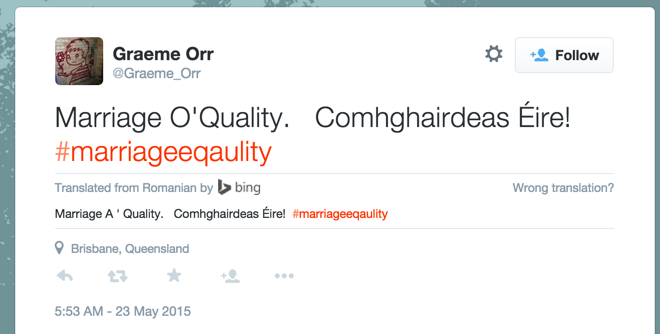Marriage O'Quality
« previous post | next post »
Tweeted by Graeme Orr:
Marriage O'Quality. Comhghairdeas Éire! #marriageeqaulity
— Graeme Orr (@Graeme_Orr) May 23, 2015
Clicking on "View Translation", Graeme was fascinated to learn that his combination of neologism and Gaelic is actually… Romanian!

acutia said,
May 23, 2015 @ 8:33 am
Microsoft's Bing (unlike Google Translate) does not translate and cannot recognise Irish.
In my own timeline, I've seen it tag tweets in Irish as Hungarian, Slovak, Czech, and French. No Romanian so far.
Graeme said,
May 24, 2015 @ 1:00 am
Ah. I was using the Twitter App for iPhone. It automatically labelled the tweet with a 'Translate from Romanian' option, next to an icon of the world but no mention of Bing.
Maybe it should have a default 'Translate from Indo-European' option?
Paul Cowan said,
May 25, 2015 @ 8:43 am
What's shocking about Google Translate is that it can't do Scottish Gaelic at all. Always imagines it's Irish ! Which naturally leads to, euh, some even more approximate renderings.
Alec said,
May 25, 2015 @ 1:43 pm
Has anyone seen an image of the actual ballot papers? Just wondering how the options were worded in Irish given that – at least as I understand it – there are no words specifically for "yes" and "no". I've seen pictures of "yes" buttons that say "Tá".
Chris C. said,
May 26, 2015 @ 7:48 pm
@Alec — very first hit on a Google image search for -irish referendum ballot paper- : http://www.referendum2011.ie/wp-content/uploads/2011/10/sample-ballot-paper-2.jpg
Graeme said,
May 27, 2015 @ 6:17 am
It's distinctly technocratic to organise a referendum ballot paper that nowhere mentions the substance of the proposition. I guess it avoids debates over whether the use of terms like 'marriage equality' vs 'gay marriage' tilt the framing of the question at the moment of final choice.
(Confession of a nerd – I just published a book on elections as rituals. Students of semiotics will be amused by a story from the recent UK poll, of a ballot that consisted of the elector drawing a male 'member' in the box opposite the conservative member's name. It was counted for the conservative candidate as the ballot was technically marked).
Neil Tarrant said,
May 27, 2015 @ 10:00 am
@Graeme,
The ballot paper listed actually refers to a rather dry amendment to the constitution from 2011: "The Thirtieth Amendment is a proposal to grant full investigative powers to Oireachtas committees investigating matters of public interest" (this was rejected).
The ballot paper from 2015 actually did use the term "Marriage Equality", although in a similar not-quite asking the question construction: "Do you approve of the proposal to amend the Constitution contained in the undermentioned Bill? Thirty-fourth Amendment of the Constitution (Marriage Equality) Bill 2015".
Cite: http://www.thejournal.ie/marriage-referendum-ballot-paper-2044764-Apr2015/
per incuriam said,
May 30, 2015 @ 8:36 pm
@Alec
there are no words specifically for "yes" and "no". I've seen pictures of "yes" buttons that say "Tá"
The way the referendum question is framed in Irish is indeed somewhat contrived, presumably so as to permit of a concise answer ("Tá/Níl") rather than the more natural "Toilim/Ní thoilim" ("I approve/I do not approve").
Then again the English is also off in that the answer to "Do you" should surely be not "Yes" but "I do".